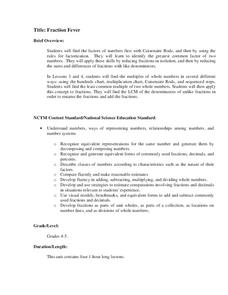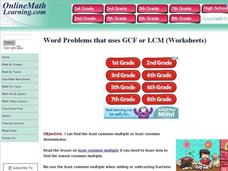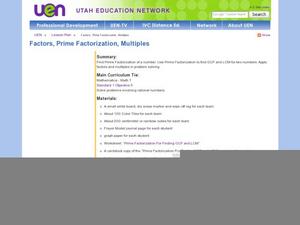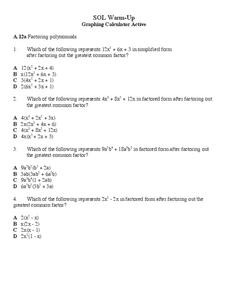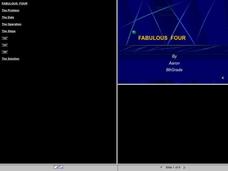Curated OER
Greatest Common Factor
In this GCF learning exercise, students fill in missing numbers in factor trees and write the prime factorization to find the greatest common factor. Worksheet includes links to answers and additional worksheets.
Curated OER
Greatest Common Factor #2
In this GCF worksheet, students fill in missing number in factor trees, then determine whether numbers are prime or composite. Worksheet includes links to answers and additional worksheets.
Curated OER
Factors for Grade 6: HCF, GCD and GCF
In this factors for grade 6: HCF, GCD, and GCF worksheet, 6th graders answer 10 multiple choice questions, about factors and divisors, with answers available online.
Curated OER
Worksheet #9 - Factoring Polynomials
Factoring practice using the GCF, difference of squares, and factoring by grouping is included in this worksheet. Questions are either short answer or multiple choice.
CK-12 Foundation
Monomial Factors of Polynomials: Mystery Boxes
Shortcut the work in finding total volumes. Pupils determine a polynomial expression that would represent the combined volume of three boxes. Each box has the same height, and the scholars rewrite the expression by factoring out the...
Curated OER
Least Common Multiple
Give students detailed instructions on how to find the Least Common Multiple as well as practice with this thorough introductory worksheet. Instructions for this worksheet include an explanation of both guess and check as well as prime...
National Security Agency
Fraction Fever
This unit on fractions allows for upper-aged elementary learners to explore ways to find the greatest common factor and least common multiple of two numbers. Ultimately, young mathematicians will be able to identify equivalent fractions,...
CK-12 Foundation
Common Multiples: Sports Calendar
Using a calendar, basketballs, and tennis balls, young mathematicians determine the common multiples of four and six. Individuals drag and drop the balls onto the correct dates each sport will be played, allowing them to see which days...
Curated OER
Prime Factorization: Finding Factors in the Fifth Grade
The lesson starts out with a brain drain, which is a great way to get students to activate prior knowledge and build lasting connections. They tell everything they know about prime factorization, use their knowledge to...
Online Math Learning
Word Problems That Use GFC or LCM
This is a webpage that contains five word problems requiring learners to find the least common multiple or least common denominator.
Scholastic
Study Jams! Least Common Multiple
RJ instructs your sixth graders in two different methods of determining least common multiples. The first is by listing several multiples of each number, and the second is by drawing factor trees. This is an ideal flipped classroom...
Granite School District
6th Grade CCSS Math Vocabulary Word List
Simplify the Common Core Math Standards for sixth graders with this comprehensive list of key vocabulary. Complemented by a series of word cards that support the meaning of each term with images and examples, this resource provides...
Curated OER
Factors, Prime Factorization, Multiples
Seventh graders examine Prime Factorizations, Multiples, and Factors. In this prime number, factorization, and multiples lesson plan, 7th graders identify greatest common factors and least common multiples. Students use problem solving...
Curated OER
Highest Common Factor and Lowest Common Multiple
In this factors and multiples worksheet, students solve 50 problems in which the greatest common factor (GCF) and the lowest common multiple (LCM) are calculated. This page is intended for online use but may be completed on paper.
Curated OER
Paper Pool
Learners explore ratio and proportion, GCF, and LCM. In this middle school mathematics lesson, students play an interactive Paper Pool game that provides an opportunity to increase their understanding or ratio, proportion, GCF, and LCM....
Curated OER
Number Sense and Operations
In this number sense and operations activity, students solve 15 different problems that include number lines and identifying various types of numbers. First, they solve a given equation and then check their work. Then, students find the...
Curated OER
Factoring Polynomials
In this factoring polynomials worksheet, 9th graders solve and complete 33 different multiple choice problems. First, they determine the equation that best represents a simplified form after factoring out the GCF. Then, students...
Curated OER
Multiples
For this multiples worksheet, students complete multiple choice questions about multiples of a number and common factors of numbers. Students complete 10 questions.
Curated OER
LCM: Factor Trees, Numbers Up to 10
Fourth and fifth graders complete factor trees to find the lowest common multiple out of the two numbers given up to the number 10. Students complete four problems.
101 Questions
Shipping Routes
The product of the hard work is learning. Scholars use a simulation tool to collect information to analyze. They must decide when two ships traveling back and forth across a river at different rates will meet on the same side. The intent...
Curated OER
Factoring
In this math worksheet, learners complete problems involving factoring. In the first section, they find all factors of a number. Students find the least common multiple and the greatest common factors. This is a worksheet generator. The...
Curated OER
Mastering Math Vocabulary
Fifth graders investigate factors by utilizing mathematical terms. In this number sense lesson, 5th graders discuss and define terms such as factors, multiples, and denominators. Students create a Venn Diagram when completing common...
Helping with Math
Factors With Prime and Composite Numbers (1 of 2)
Math monsters examine nine numbers, factor them, and then determine if they are composite or prime. You can print this worksheet off of the website, but it does not fit neatly onto one page. Consider projecting it on your class screen...
Curated OER
Factoring
Show how to factor four different numbers using a factor tree. This short slide show defines factoring and then shows how each number 28, 32, 33, and 30 can all be factored.








